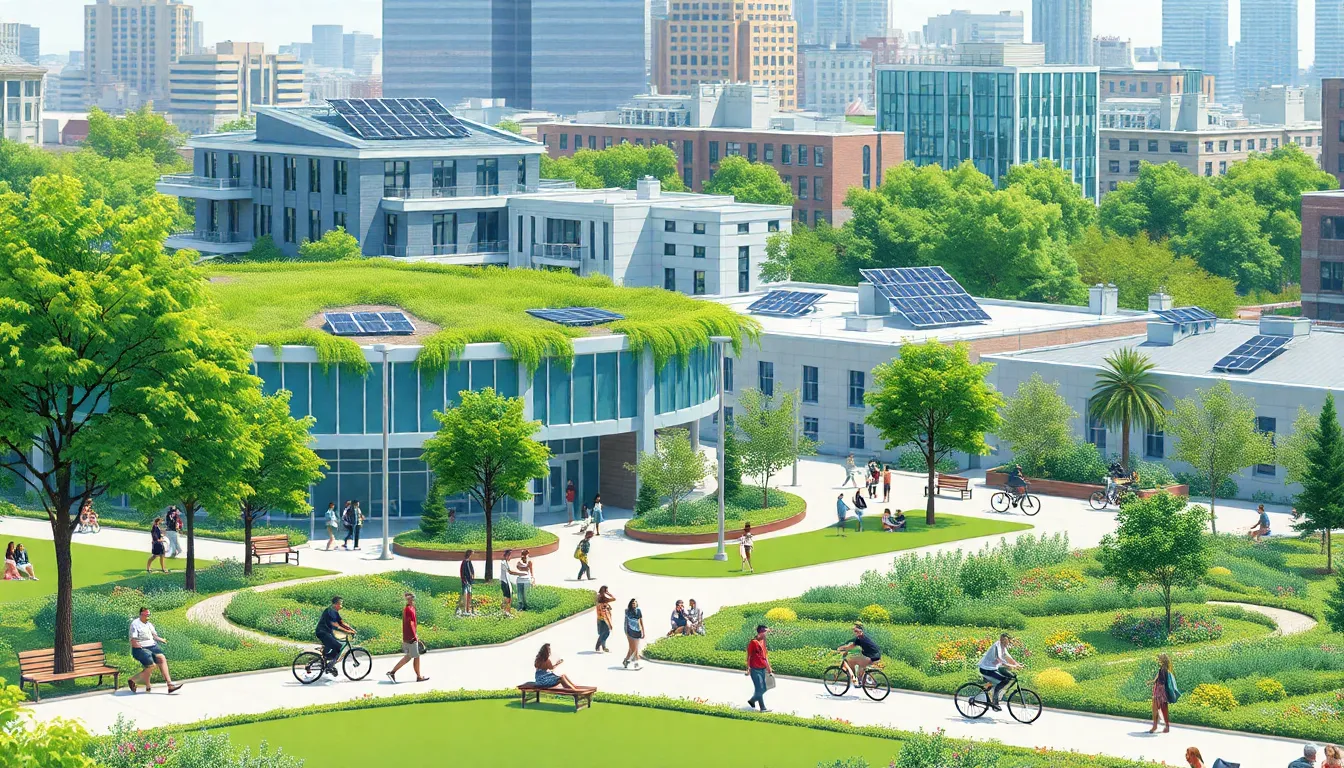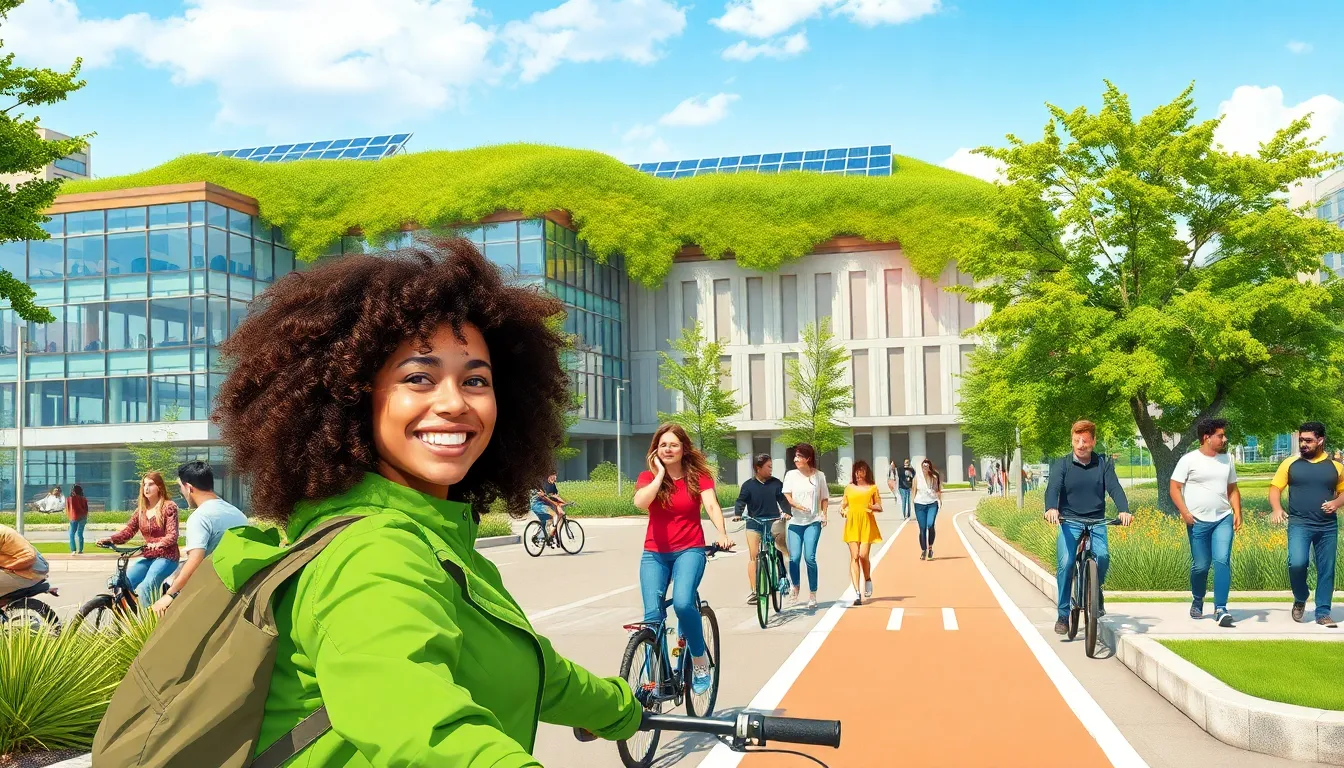Imagine a world where buildings breathe, roads drink rainwater, and parks throw shade like a pro at a beach party. Eco-friendly infrastructure isn’t just a buzzword; it’s the superhero cape that urban environments need to combat climate change. As cities grow and our planet warms, the pressure’s on to transform concrete jungles into sustainable paradises.
From solar panels that dance in the sunlight to green roofs that could host a picnic, eco-friendly designs are reshaping how we think about our surroundings. It’s not just about saving the planet; it’s about creating spaces that make life a little brighter—and a lot greener. Dive into the world of eco-friendly infrastructure and discover how these innovative solutions can turn our everyday environments into thriving ecosystems.
Table of Contents
ToggleWhat Is Eco-Friendly Infrastructure?
Eco-friendly infrastructure refers to the design, construction, and operation of facilities and systems that prioritize sustainability. This concept incorporates environmentally responsible practices in urban settings, aiming to reduce ecological footprints. Key elements often include renewable energy sources, efficient waste management systems, and resource conservation techniques.
Green roofs serve as an excellent example of eco-friendly infrastructure. These installations not only provide insulation but also support biodiversity by creating habitats for various plant and animal species. Similarly, solar panels harness sunlight, converting it into energy that powers homes and buildings, thereby decreasing reliance on fossil fuels.
Rainwater harvesting systems capture and store rainwater for irrigation and other non-potable uses. Such systems reduce water consumption and alleviate pressure on municipal water supplies. Sustainable transportation options, including bike lanes and electric vehicle charging stations, promote eco-friendly commuting alternatives, enhancing a city’s overall sustainability.
Incorporating green spaces into urban designs significantly improves air quality and provides recreational areas for residents. These parks and gardens contribute to mental well-being and foster community interactions. Using eco-friendly materials in construction minimizes the environmental impact and promotes healthier living conditions.
By prioritizing these practices, cities move toward becoming resilient, sustainable environments. Enhanced aesthetics and improved quality of life emerge from investments in eco-friendly infrastructure. Stakeholders must recognize the importance of integrating such innovations to address climate challenges effectively.
Benefits of Eco-Friendly Infrastructure

Eco-friendly infrastructure offers numerous benefits that promote a sustainable future. Improved environmental health and economic growth stand out among the many positive impacts.
Environmental Impact
Eco-friendly infrastructure significantly reduces carbon emissions. Utilizing renewable energy sources like solar and wind power helps minimize reliance on fossil fuels. Incorporation of green roofs contributes to biodiversity by providing habitats for urban wildlife. Efficient waste management systems lower landfill contributions, leading to cleaner surroundings. Rainwater harvesting techniques improve water conservation, which eases stress on local resources. Sustainable building materials reduce environmental degradation, promoting a healthier ecosystem. Overall, these innovations create urban spaces that support both nature and human well-being.
Economic Advantages
Economic growth thrives alongside eco-friendly infrastructure. Energy-efficient buildings lower utility costs, providing savings for businesses and residents. Incentives for adopting sustainable practices stimulate job creation, driving local economies. Increased property values in green neighborhoods attract investment and tourism. Furthermore, sustainable transportation options lower commuting costs, enhancing accessibility across cities. As these developments take hold, communities experience long-term financial benefits while fostering fiscal responsibility. Eco-friendly infrastructure ultimately combines economic prosperity with environmental stewardship, paving the way for a brighter future.
Key Features of Eco-Friendly Infrastructure
Eco-friendly infrastructure incorporates several key features that promote sustainability and enhance urban living. These features significantly contribute to reducing the ecological footprint of cities.
Sustainable Materials
Sustainable materials play a crucial role in construction practices. They include recycled, reclaimed, and rapidly renewable resources. Using these materials reduces waste and minimizes the extraction of raw resources. For instance, bamboo and reclaimed wood serve as excellent alternatives to traditional timber. Additionally, products that emit low or zero volatile organic compounds improve indoor air quality. Such choices support healthier living environments. Sustainable materials also often feature longevity, reducing the need for frequent replacements, which conserves resources over time.
Energy Efficiency
Energy efficiency remains a cornerstone of eco-friendly infrastructure. Utilizing energy-efficient designs and systems reduces energy consumption significantly. Buildings equipped with high-performance insulation and energy-efficient windows promote thermal comfort while minimizing reliance on heating and cooling systems. Solar panels provide a clean source of energy that can power both residential and commercial spaces. Moreover, the integration of smart technologies enables real-time energy monitoring. When combined, these elements create a substantial decrease in carbon emissions and lower utility costs. By focusing on energy efficiency, infrastructure not only benefits individual occupants but also contributes to broader environmental sustainability.
Case Studies of Successful Eco-Friendly Infrastructure
The Bullitt Center in Seattle represents a pioneering model of green building. This structure uses solar panels to generate more energy than it consumes annually. Additionally, its rainwater harvesting system supplies 100% of its water needs, showcasing innovative water management techniques.
In Europe, the Bosco Verticale—Vertical Forest—located in Milan embodies urban forestry principles. This residential complex features over 9,000 trees and promotes biodiversity while improving air quality. Each balcony acts as a mini garden, providing insulation and reducing energy demands.
Singapore’s Gardens by the Bay offers an exemplary case of integrating nature with urban life. This city park utilizes solar technology for energy generation and rainwater collection systems for irrigation. These elements create a sustainable environment while enhancing the city’s aesthetic appeal.
Another noteworthy project is the High Line in New York City. This elevated park transforms an old railway line into green space, encouraging biodiversity and community interaction. By incorporating native plants, it reduces maintenance needs and supports local ecosystems.
The construction of the Adelaide Central Market in Australia highlights the use of sustainable materials. Reclaimed wood and recycled concrete were essential to its eco-friendly design. This approach serves as a model for reducing waste in urban construction.
Toronto’s Evergreen Brick Works displays versatile eco-friendly infrastructure through its design and operation. This site engages in community education about sustainability while using renewable energy sources for daily operations. Additionally, its landscaping prioritizes local flora, promoting biodiversity.
These case studies demonstrate the effectiveness of eco-friendly infrastructure in various urban settings. By implementing innovative strategies, cities can mitigate environmental impacts while improving the quality of life for residents.
Challenges in Implementing Eco-Friendly Infrastructure
Implementing eco-friendly infrastructure involves various challenges that cities must navigate. High upfront costs often deter investment in sustainable projects, even with long-term savings. For instance, transitioning to energy-efficient buildings requires significant capital outlay that some municipalities struggle to justify.
Regulatory hurdles also present obstacles. Cities may face outdated zoning laws that hinder the integration of green technologies. Modifying these regulations can take time, delaying the implementation of innovative solutions.
Another challenge relates to public perception. Residents may resist changes due to misconceptions about eco-friendly infrastructure’s practicality and benefits. Educating communities about the advantages of green initiatives plays a crucial role in gaining support.
Technical expertise is essential for the design and maintenance of eco-friendly systems. Cities often grapple with a lack of skilled professionals familiar with sustainable construction practices. Investing in training and development programs can help bridge this gap.
Funding sources are limited. Traditional financing models may not prioritize sustainable projects, making it difficult to secure necessary resources. Exploring partnerships with private sectors and non-profits could provide alternative funding opportunities.
Lastly, climate variability can impact the effectiveness of implemented solutions. Cities must consider local environmental conditions when designing eco-friendly infrastructure to ensure long-term viability. Utilizing climate data helps tailor projects that withstand potential challenges.
Navigating these challenges requires collaboration and commitment across various sectors. By addressing these barriers, cities can pave the way for sustainable urban environments that improve quality of life for all residents.
Eco-friendly infrastructure represents a crucial shift towards sustainable urban living. By integrating innovative designs and renewable technologies, cities can significantly reduce their environmental impact while enhancing the quality of life for residents. The successful implementation of these practices not only promotes ecological balance but also stimulates economic growth through job creation and increased property values.
Overcoming challenges such as high initial costs and regulatory barriers requires collaboration among stakeholders. As communities embrace eco-friendly solutions, they pave the way for resilient urban environments that prioritize both environmental stewardship and community well-being. Investing in sustainable infrastructure is not just a necessity; it’s an opportunity to build a better future for generations to come.



